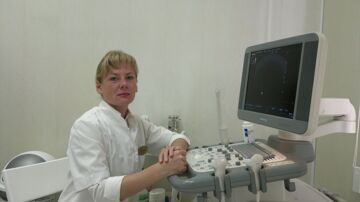Every woman involuntarily thinks about the onset of conception if she experiences characteristic symptoms or experiences a delay in menstruation. The fastest way to determine a possible early pregnancy is to do a rapid test. In case of positive or contradictory results, he may push the woman to go to the gynecologist for an ultrasound. But at what day of delay will an ultrasound show pregnancy? And when should you go for testing? You will find answers to these questions below.
How is pregnancy determined?
The first and most important rule that any woman should learn is that you should not run to an ultrasound at the first missed period. Ultrasound diagnostics is an ineffective method for very early periods of gestation. Therefore, to understand whether a woman needs to make an appointment with a doctor, she needs to do a home rapid test. They are readily available in pharmacies, and the results are quite informative. How does he work?
Fertilization of the egg occurs during ovulation. If this happens, then after a certain period of time the production of the pregnancy hormone, human chorionic gonadotropin (hCG), begins. It is on the presence of a reaction to this hormone that the work of any rapid test is based.
To carry out the test, a paper strip soaked in the reagent must be kept in urine for some time or simply urinated on it. One strip on the test is always a control, the second determines the presence of this hormone (if it appears) or its absence (if the strip does not appear).
In the morning, the concentration of hCG in the urine is maximum, so doctors recommend taking the test in the morning. A test taken during the day or evening may be incorrect. This happens due to the liquid you drink throughout the day. As a result, the concentration of the hormone may decrease. It is also necessary to carefully check the packaging and expiration date of the test during purchase to avoid distortion of the results.
To determine conception as early as possible, it is better to use particularly sensitive tests. With their help, you can establish conception already in the first days of delay.
How many of these tests can be performed? They are safe, because the amount depends entirely on desire.
How to determine pregnancy
If you have the slightest doubt, be smart and go to the clinic for a quick diagnosis of a possible pregnancy. After all, if “something happened”, it will not go away on its own; do not bring yourself to a situation where the obvious movement of the growing child in the noticeably rounded belly becomes a reason for the expectant mother to visit an obstetrician-gynecologist. Next, we will consider the main methods that will determine the time of conception in weeks earlier and more accurately and where it is better to start.
1. PHARMACY TEST. If there is no menstruation for 1-2 days or more, you can use a pharmacy test and check at home, getting an answer to the question “Am I pregnant?” Most of them detect the presence of conception from the first day of a missed period. The test is fast, cheap, easy to use and quite reliable.
2. DONATE BLOOD FOR HCG. The answer to your question can be obtained if you take a blood test from a vein for hCG, and after a while you get the result. In this case, the level of a hormone, trophoblastic beta globulin, is measured. It can be detected by the earliest diagnosis of pregnancy from the first day of delay. This analysis provides more reliable information, and first of all, about the expected time of possible conception. In this case, not only the presence of hCG is important, but also at each stage of fetal development. It reaches its highest level at 10-11 weeks, then gradually decreases. Sometimes women carry out this analysis even before the first day of absence of the next menstruation. The results of the study of hCG levels by week can be seen in the photo below.

3. DIAGNOSTICS BY ULTRASOUND. The only reliable way to accurately determine your health status is to determine pregnancy using an ultrasound. Using this method, you can obtain information about the presence of a growing fertilized egg and its location starting from 2.5 - 3 weeks from conception. Using it, already from the 4-5th week, a specialist will determine: the location of the embryo; anomalies such as hydatidiform mole; gestational age in weeks; number of embryos; threats to pregnancy; amount of amniotic fluid.
You can find out about pregnancy in the early stages even earlier and more accurately if you perform an ultrasound with a transvaginal sensor. This method is preferable due to its information content, painlessness, lack of discomfort and the ability to obtain reliable diagnostic results at the very initial stage.

4. CHAIR INSPECTION. Is it worth going to an appointment with a gynecologist if there is a delay and suspicion of conception? Costs. First of all, to check for pregnancy and clarify that it is in the uterus. Tests and blood tests for hCG in the early stages equally give a positive result for both uterine and ectopic localization of the fertilized egg. And only an examination by a doctor and a gynecological examination in a chair can accurately clarify the situation.

How to quickly find out about pregnancy
The shortest way to know about the possible conception of a child is to do an ultrasound of the pelvis. You can get the result in your hands immediately in the office of an ultrasound specialist, and it is better to do this after 3-5 days of delay, and choosing the transvaginal method will allow a specialist at our clinic (Kutuzovsky Prospekt, 35, Moscow) to determine pregnancy urgently, as as soon as possible and as accurately as possible.
COST OF SERVICES
| Diagnostic methods: | Prices |
| Pelvic ultrasound | 3 000 |
| Blood test for hCG | 850 |
| Appointment with a gynecologist with examination | 2 500 |
| Test strip | pharmacy price list |
Has the gynecologist determined pregnancy? Find out what to do next if she:
| Desired | Unwanted |
When to suspect pregnancy
There are several signs when you should take a pregnancy test:
- unusual sensations in the chest and pelvis area, breast swelling;
- drowsiness, lethargy;
- change in appetite or lack thereof;
- a previously unusual aversion to certain odors;
- the appearance of skin pigmentation, allergies, rashes;
- changes in the nervous system (irritability);
- dizziness, nausea.
If a woman is healthy and does not suffer from any menstrual irregularities, then determining her “interesting position” is quite simple - any deviation from the schedule, even for 2-3 days, can serve as a reason for conducting a test.
Early signs of pregnancy
What symptoms can you suspect pregnancy? The body itself sends signals from which the necessary conclusions can be drawn. Women with maternal experience in the early stages may feel these changes and assume that a new addition to their family awaits them. If the child is the first, it turns out to be much more difficult to understand what is happening. Obstetric science, based on the timing of appearance in girls, identifies several groups of pregnancy symptoms (doubtful, probable and reliable). Let's look at each of them.

Doubtful (unlikely) signs:
- Changes in eating behavior.
- Perverted taste preferences.
- Violation of olfactory sensations.
- Variability of the nervous system.
- Weakness, malaise, drowsiness.
- Increased vaginal discharge.
- Frequent urination.
- Spotting of blood on the days of expected menstruation.
- Pain in the lower abdomen and vagina.
- Skin pigmentation (face, nipples, genitals, linea alba).
- Increased or decreased libido.
- Changes in appearance (breast enlargement, swelling, etc.).
- A woman's premonition (intuition).
Probable (acceptable) signs:
- Stopping menstruation.
- The appearance of colostrum from the nipples.
- Changes in the size, shape and consistency of the uterus.
- Cyanosis of the mucous membrane of the cervix and vagina, external genitalia.
Reliable symptoms:
- Ultrasound detection of the fertilized egg in the uterus.
- Visualization of the contraction of the heart of the embryo (fetus) with ultrasound.

On what day of delay should ultrasound and tests be done?
If you have sexual intercourse without proper protection, conducting a home test 20–25 days after it will not hurt. This is especially true if your period is late.
Carrying out tests and research is advisable not only when there is a lack of menstruation. An indication for the test may also be an unusual course of menstruation, an early onset or their scarcity. Such symptoms may also indicate a possible pregnancy. In addition, women often experience continuation of menstrual flow after conception.
It is important to remember that periods during pregnancy are normal only in the first month, because fertilization of the egg can occur at the very end of the cycle. And this is the only case when an ultrasound will show pregnancy before the delay. If they continue, you need to urgently go to a gynecologist.
HCG analysis
After a positive pregnancy test, the next step should definitely be a visit to the gynecologist. To confirm or refute pregnancy, a gynecologist will prescribe a blood test for hCG. The test can be taken as early as 14 days after unprotected sexual intercourse. If it turns out to be positive, then the woman will be sent for an ultrasound examination (ultrasound).
Ultrasound
It does not matter where such diagnostics will take place: in a regular clinic at your place of residence or in the best diagnostic center in Moscow. It is important that the device is capable of displaying images in high resolution and has advanced functionality.
Pregnancy can only be determined if there is an embryo in the uterus. But the fetal sac is very small in the early stages of its development, so it is very difficult to see it. And only good equipment and the professionalism of an ultrasound specialist can be the key to a successful diagnosis. And yet, on what day of delay can an ultrasound be done? Ultrasound can detect the presence of a fetus after the fourth week. This period is equal to a week after the start of the delay.
If a woman has small fat deposits in the abdominal area, then a qualitative study can be carried out only two weeks after the start of the delay.
Delay of menstruation
admin Menstrual cycle disorders Delayed menstruation Delayed menstruation is considered a condition when menstruation is “delayed” for more than 5-7 days from the date of the expected start of the cycle. The beginning of the cycle is considered the first day of menstruation. The time from the first day of menstruation to the first day of the next menstruation is the cycle. A normal break between two periods, that is, the duration of the menstrual cycle can be from 21 to 45 days. In any case, a cycle duration of 21 to 45 days is the norm, provided that the cycle is stable and always repeats after the same period of time. If you are experiencing a delay for a longer period of time (for example, a week or more), you first need to make sure that the delay is not related to pregnancy. In the event that the fact of pregnancy is not confirmed and menstruation does not occur, it is necessary to find out the reason and determine the presence of pathology. It is possible to rule out pregnancy with the help of a doctor’s examination and an ultrasound of the pelvic organs. Any deviation from the norm in the female reproductive system requires an urgent and thorough examination. To do this, you need to visit a gynecologist. Delayed menstruation occurs at different periods of a woman’s life: during the formation of menstrual function, during the reproductive period and during premenopause. A delay of menstruation for more than five days is a reason to consult a doctor. There are natural and pathological reasons for the absence of menstruation. If it is determined that the absence of menstruation is not associated with natural physiological processes occurring in a woman’s body, then you should contact a specialist to diagnose possible abnormalities that led to a delay in menstruation. In the event that this is not associated with the norm, the absence of menstruation for several days to several weeks or even months may be a symptom of a serious illness that requires a full examination by specialists and the prescription of the necessary treatment to normalize and regulate the stability of the cycle. Often, one of the most common physiological causes of delayed menstruation is pregnancy. Including ectopic. If there is a delay of 5 days or more, it is recommended to do two different tests. If the pregnancy test is clearly positive, you should consult a doctor and sign up for an ultrasound of the pelvic organs. If the presence of intrauterine pregnancy is confirmed, then the patient continues to be monitored by a gynecologist, but naturally forgetting about the problem of lack of menstruation. In addition to pregnancy, in the absence of menstruation, such a concept as the anovulatory cycle is also considered. This phenomenon can occur in many women several times a year. It is also a physiological norm that does not require therapy. Most often, anovulatory cycles are observed in women at certain times of the year and are repeated from year to year without causing concern. After one such cycle, the arrival of menstruation returns to its previous normal. Also, the absence of menstruation is the norm during puberty. During hormonal development, various changes in the menstrual cycle are common. Delayed menstruation can occur up to 2 years after the onset of the first menstruation. This phenomenon is a physiological norm and does not require medical intervention or special therapy. If problems with the duration of the cycle are observed for more than 2 years, and disturbances in the ovulatory-menstrual cycle bother the girl, then in this case a consultation with an endocrinologist or gynecologist-endocrinologist is necessary. A similar, but let’s say “backwards” situation is the period of “menopause”, when the cycle ceases to be regular and over time the female body, having ceased to perform the reproductive function, no longer shows this by monthly bleeding. In this case, you should still undergo preventive observation by a gynecologist to exclude pathologies that often occur in menopausal women. It is only permissible to undergo an ultrasound of the pelvic organs and some clinical tests for changes in hormonal levels on your own. In addition to the above, being overweight can affect the onset of your period as expected. Excess fat leads to the accumulation of estrogen and their transformation into androgens. Against this background, hyperandrogenism develops, leading to problems with ovulation and delayed menstruation. Often, with obesity and menstrual irregularities due to excess weight. girls make a mistake, that is, they begin to exhaust the body with diets, which also has a detrimental effect on the hormonal background of the body, which in turn is responsible for the onset of menstruation. A rapid diet, increased physical activity... all this tortures the body, which leads to the cessation of estrogen production by the body. Estrogen is not produced due to exhaustion; this hormone requires a fat layer. Exhaustion causes hypoestronia, which leads to cessation of ovulation. Normalizing the diet, introducing a sufficient amount of healthy and balanced foods into the diet helps restore the cycle. Often it is impossible to restore the cycle without treatment from a gynecologist-endocrinologist. The norm for the absence of menstruation can also be the period of lactation and the postpartum period of up to six months. This is due to the restructuring of the hormonal health of the body. Another reason for delayed periods is stress. Stress can be associated with the first sexual intercourse, work, moving, studying, personal tragedy or death of a loved one, long-term illness of relatives, physical activity for which the woman was not mentally prepared.
Pathological causes of delayed menstruation can be gynecological and endocrinological abnormalities in the body. These include - the presence of cysts or polycystic ovary - inflammatory processes of the appendages - malignant and benign tumors of the uterus - cervical cancer - adnexitis and salpingo-oophoritis - genitourinary tract infections - sexually transmitted diseases - termination of pregnancy - spontaneous miscarriage - endometritis - cancer can also be the cause cervix - incorrectly installed intrauterine device - Thyroid gland dysfunction - Diabetes mellitus
If at least one of these diseases is present or suspected, it is necessary to conduct an ultrasound of the small organs. In some cases, an ultrasound of the thyroid gland and a consultation with an obstetrician-gynecologist or a gynecologist-endocrinologist. Do not self-medicate under any circumstances. Since only after extensive diagnostics and a number of studies, such as ultrasound of the thyroid gland, ultrasound of the pelvic organs, blood tests for changes in hormonal parameters, taking smears and other diagnostic methods, specialists establish an accurate diagnosis and fight the cause of irregularities in the cycle and the absence of menstruation . For prevention, it is necessary to undergo a routine examination with a gynecologist once a year, and for women over 35 - twice a year.
Types of ultrasound diagnostics
There are two modern methods:
- Transvaginal ultrasound. It is used after the third week of pregnancy, that is, on the 7th–10th day of delay. The countdown is from the first day of the last menstruation. This technique is rarely used at earlier stages, since for a qualitative study the size of the embryo should be about 0.5-0.7 cm and before it simply will not be visible. It is more often used as a screening.
- Transabdominal ultrasound. This study is carried out with a device whose sensor is placed on the front wall of the abdomen. In this case, the distance to the uterus is quite large. This nuance allows for accurate diagnosis no earlier than the fifth week and later. Otherwise, the results may be erroneous. Both methods are considered safe and cannot in any way harm the woman’s health or affect the development of the embryo.
The following types of ultrasound are performed at the Bionics clinic:
There are 4 types of ultrasound of the pelvic organs in gynecology. Characteristics of each:
- The transrectal type is the insertion of a sensor through the rectum, performed on girls who are not sexually active. Not used to determine pregnancy.
- Transvaginal type - the sensor is inserted through the vaginal tract to the uterus and is considered the most accurate in detecting pregnancy in the early stages.
- Transabdomial view is an examination using a special probe without penetration, inserted into the body through the anterior wall of the abdominal cavity. But the method does not guarantee an accurate pregnancy result in the early stages.
- A combined examination is performed by trans-abdominal and vaginal ultrasound.
The most popular and recommended way to detect pregnancy in the early stages is the transvaginal method. Although there are contraindications and risks of complications. For any questions, please contact the clinic’s specialists and the information on the website.
Preparation for ultrasound examination
Before going for a transvaginal ultrasound, a woman should empty her bladder. If we are talking about a transabdominal ultrasound, then it should be complete. To do this, you will have to drink about a liter of water half an hour before the procedure, even if you don’t really want to. In emergency cases, fluid can be administered using a catheter.
If in doubt, a woman should undergo an ultrasound no earlier than the tenth day, when the ultrasound will show pregnancy after a delay. Then the device is able to show the fertilized egg in the uterus. But the examination can give a 100% guarantee only after the twentieth day of delay. During this period, you can already hear the heartbeat of the unborn child. This will be absolute proof that the woman is pregnant and will help rule out a number of pathologies. One of them is anembryony - the presence of a fetal sac without an embryo in it. This pathology is accompanied by all the signs of pregnancy, however, in essence it is not it.
Ultrasound of the pelvis in women, how to prepare? On what day of the menstrual cycle is it performed?
Olga Viktorovna Elistratova, an obstetrician-gynecologist at the Personal Doctor clinic, answers our questions.

Ultrasound of the pelvic organs is FREE for VIP patients in the branch in the city of Kolpino until the end of July 2021. Present an SMS with an invitation at the reception and perform a preventive ultrasound of the pelvic organs for free! Find out more details at the reception by calling the clinic.
The promotion is carried out exclusively by special invitation, for those who have been assigned VIP status. The duration of the promotion is from July 7, 2021 to July 31, 2021 at the branch of the Personal Doctor clinic at St. Petersburg, Kolpino, st. Communi no. 23. You will receive a conclusion about the ultrasound performed. Attention! This promotion applies only to ultrasound of the pelvic organs for women (not screening). Doctor's consultation and laboratory tests are performed if necessary and are paid separately.
Sign up now, hurry up, because the number of free ultrasounds is limited!
Olga Viktorovna, please tell us why we need to examine the organs located in the woman’s pelvis using ultrasound? Nowadays, ultrasound diagnostics is a relevant, in demand and very necessary tool in the practice of many doctors. In particular, ultrasound examination (US) is extremely important in obstetric and gynecological practice, where ultrasound of the pelvic organs helps to diagnose and also timely identify many diseases of the internal female genital organs, which include the ovaries, uterus, and the inside of the cervix.
When should a pelvic ultrasound examination be performed? When nothing worries you and you would just like to make sure that everything is in order, an ultrasound examination of the pelvic organs is performed on the fifth, sixth or seventh day of the cycle, counting from the first day of bleeding. It is necessary to be examined precisely at this time to better assess the condition of the endometrium, the structure of the ovaries, the follicular apparatus and visualization of myomatous nodes. If there is a need for a repeat examination, the doctor will advise you on what day it is best to repeat the examination again. If you are bothered by pain of any kind in the lower abdomen or locally in the projection of the uterine appendages, then you should not strictly adhere to the first days of the onset of the menstrual cycle. It is possible and NEEDED to perform an ultrasound of the pelvic organs on any day of the menstrual cycle, without delay and preferably as soon as possible, in order to diagnose the cause of pain as quickly as possible and refer you to a consultation with a gynecologist or, possibly, even a surgeon. If menstruation is delayed, an ultrasound examination is also performed regardless of the day of the cycle. If you are sexually active and your period does not come on time, be sure to take a pregnancy test and report the result to your ultrasound doctor before the ultrasound examination. If you constantly have irregular, unsteady menstrual cycles, also tell your doctor about this.
What preparation is required for an ultrasound examination? Ultrasound of the female pelvic organs can be performed through the anterior abdominal wall (transabdominal ultrasound), for this a transabdominal probe is used, and from the vagina (transvaginal ultrasound), a transvaginal probe is used. Currently, priority is given to the use of a transvaginal sensor (provided that you are sexually active), since this sensor is more sensitive and allows you to clearly visualize the structure of the internal genital organs, provides the highest quality image of various pathological conditions, including organ neoplasms, located in the woman's pelvis. Basic preparation - the study is performed with an empty bladder. Transabdominal ultrasound examination of the pelvic organs is performed in women who have never had a sexual partner (never had sexual intercourse) and is performed only with a full bladder, using a special transabdominal convex sensor. This sensor is also used to conduct fetal screening studies at different stages of pregnancy. Preparation before an ultrasound of the pelvic organs includes mandatory clarification on your part when you had the first day of your last menstruation (according to the calendar), and what day of the cycle at the time of the ultrasound. You must inform your doctor about this immediately before starting the study.
Pelvic ultrasound performed - what next? The conclusion of the ultrasound examination protocol is not a diagnosis! This is a description of the state of your internal organs at the time they were examined by a doctor using ultrasound. Treatment ONLY based on ultrasound examination data is not prescribed! If during the study any pathology is discovered, you must consult a gynecologist with this protocol! Only after a full consultation with a gynecologist who will conduct a survey of complaints, collect an anamnesis of the disease, perform a gynecological examination, carefully study the results of an ultrasound of the pelvic organs and evaluate the entire clinical picture as a whole, the doctor will prescribe you treatment, if necessary, or offer you observation in dynamics, it depends on the established disease. Ultrasound is an auxiliary and important additional method for diagnosing a large number of diseases and conditions of the female genital area, which may not be diagnosed during a routine gynecological examination. You need to know that an ultrasound examination of organs located in a woman’s pelvis can reveal the presence of a small uterine myomatous node, endometrial polyps, cervical polyps and cysts, early stages of pregnancy, ovarian cysts and other pathologies. An ultrasound examination cannot in any case replace an examination by a gynecologist, and vice versa. Be healthy!
For any questions, call us, make an appointment with a gynecologist and for an ultrasound!
Appointment with examination and recommendations from a doctor of the highest category
only 1800 rubles.
Ultrasound of the pelvic organs 1,700 rubles.
We have no hidden fees!
Call!
| E single number: 426-15-05 | ||
| St. Petersburg, Bolshevikov Ave., building 30, bldg. 2 (Nevsky district, metro station "Ul. Dybenko", next to Kudrovo) | ||
| St. Petersburg, Kolpino, st. Communes building 23, m. Kupchino | ||
THIS IS INTERESTING! READ!
Frequently asked questions for doctors and answers to them:
| Why do you need to consult a gynecologist if nothing bothers you or hurts? |
| What is colposcopy? |
| Delayed menstruation. What to do? |
| Vaginal discharge, itching. What to do? |
| Pain in the lower abdomen. What to do? |
| “Casual sex”, a more correct term is “casual sexual contact”. What to do? |
| Pregnancy planning. |
| Uterine fibroids - to operate or not? |
| A virus that causes cancer. |
| Oral contraceptives: harm or benefit? |
| Fetal ultrasound? Ultrasound during pregnancy? |
| Unwanted pregnancy. Medical abortion. |
| Ultrasound of the fallopian tubes. Ultrasound hysterosalpingoscopy. |
| Gynecological clinics in the Nevsky district of St. Petersburg and in Kolpino. |
| Are you looking for where to get a medical abortion (medical termination of pregnancy)? |
| Intimate contour plastic surgery - what is it? |
| A gynecologist surgeon talks about the treatment of uterine prolapse, vaginal prolapse and urinary incontinence. |
| What is thrush in women? How to cure thrush? |
| E single number: 426-15-05 | ||
| St. Petersburg, Bolshevikov Ave., building 30, bldg. 2 (Nevsky district, metro station "Ul. Dybenko", next to Kudrovo) | ||
| St. Petersburg, Kolpino, st. Communes building 23, m. Kupchino | ||
DID NOT YOU FIND WHAT YOU WERE LOOKING FOR?
1. USE THE CONVENIENT SITE SEARCH!
2. OR ASK A QUESTION TO THE DOCTOR ON THE FORUM (24 HOURS)
3. OR JUST CALL US!
M multi-channel single number: 426-15-05
Ultrasound of the pelvic organs (gynecology)

SonoAce Ultrasound Magazine
Contains current clinical information on ultrasonography and is aimed at ultrasound doctors, published since 1996.
Ultrasound examination is the most accessible and absolutely harmless examination method. It can be used to diagnose a variety of gynecological diseases and monitor their progress both in outpatient settings and in hospitals. At the current level of technology development in gynecology, it is possible to use both transabdominal (examination through the anterior abdominal wall with a full bladder) and vaginal sensors. The use of the latter is preferable due to better visualization of the internal genital organs with a more refined assessment of their structure.
Using ultrasound, you can see and evaluate the condition of the uterus, cervix, ovaries, fallopian tubes (if they are pathological) and surrounding organs. During an ultrasound, the sizes of all organs available for examination are measured, their structure and compliance with the phase of the menstrual cycle are assessed.
For the first time, an ultrasound can be performed on any day of the menstrual cycle, excluding menstruation days. If the diagnosis is unclear or requires clarification, the study will need to be repeated on a certain day. Let's look at the most common cases.
Uterine fibroids.
In the presence of this disease, it is preferable to perform ultrasound in the first phase of the menstrual cycle, immediately after the end of menstruation. This is especially true for control ultrasounds, which will need to be done 1-2 times a year. This is due to the fact that in the first phase the size of the fibroid nodes is much smaller than in the second, when their swelling is possible due to the specific action of the hormone progesterone. That is, if you do an ultrasound twice in one month, the sizes of the same nodes will differ significantly depending on the phase of the menstrual cycle. Moreover, the sizes of the nodes in the first phase of the cycle will be considered true. Ultrasound helps to reliably assess the number of nodes, their size, structure, location in relation to the walls of the uterus and the uterine cavity, which is very important for deciding on further treatment.
Endometriosis.
Using ultrasound, a diagnosis can be made when endometriotic lesions are located in the muscle of the uterus (myometrium). This is the so-called internal endometriosis or adenomyosis. With this disease, unlike uterine fibroids, it is better to conduct research in the second phase of the menstrual cycle, when the lesions are “swollen” and they are better identified during ultrasound. Also, ultrasound can determine the presence of endometrioid ovarian cysts - they have a characteristic structure. In other localizations, foci of endometriosis are practically inaccessible for visualization using ultrasound.
Inflammation of the internal genital organs.
For inflammation of the uterine appendages (adnexitis, salpingoophoritis), ultrasound can be done on any day of the menstrual cycle. However, if there is dilation of the fallopian tubes (hydrosalpinx, sactosalpinx), the study must be repeated immediately after the end of menstruation to determine whether there is additional reflux of menstrual blood into the fallopian tubes. In case of inflammation of the uterine mucosa (endometritis), it is important to evaluate the structure of the endometrium, so ultrasound must be done in both the first and second phases of the cycle.
Condition after abortion and other intrauterine interventions.
Here, it is mandatory to conduct an ultrasound immediately after the end of the next menstruation, as well as in the presence of additional indications or in the event of the development of complications (bleeding, endometritis, suspicion of remnants of the fertilized egg, etc.)
Ovarian dysfunction.
Ultrasound can help clarify the diagnosis and assess the condition of the ovaries and endometrium. To do this, it is necessary to perform an ultrasound at least twice during one menstrual cycle. This is especially important when assessing the effectiveness of treatment, when it is necessary to track whether there is a growing follicle, whether ovulation has occurred, and how the endometrium changes under the influence of hormones produced by the ovaries.
Endometrial hyperplasia.
If this diagnosis was suspected during an ultrasound scan in the second phase of the cycle, a repeat examination is necessary immediately after the end of the next menstruation to see whether the thickened endometrium and/or polyps have been independently rejected or whether medical assistance is required.
Ovarian tumors and cysts.
This diagnosis can be made with an ultrasound performed immediately after the next menstruation. In the middle and in the second phase of the menstrual cycle, quite large (about 2 cm in diameter) additional inclusions are normally detected in the ovaries - a growing follicle or corpus luteum, which, in the absence of experience from a doctor, can be mistaken for a tumor.
Suspicion of pregnancy.
If the next menstruation is delayed, using an ultrasound, you can reliably see the fertilized egg in the uterine cavity at about 5 - 7 days of the delay.
If a woman is practically healthy, for preventive purposes for the early detection of various gynecological diseases, it is necessary to do an ultrasound of the pelvic organs once every 1 - 2 years, and after the age of 40 - once a year.
SonoAce Ultrasound Magazine
Contains current clinical information on ultrasonography and is aimed at ultrasound doctors, published since 1996.
The right time for an ultrasound
The main indication for ultrasound is delayed menstruation, but it may be accompanied by additional factors:
- There is no menstruation, the test results are not clear. It may not show pregnancy at all or show an unexpressed second stripe. In this case, the doctor will first order hCG tests for you. Based on the results of the ultrasound and hCG level, the doctor will conclude that pregnancy is present.
- There is no menstruation, the test shows a positive result, but no signs of pregnancy were found during a gynecological examination. In this case, transvaginal ultrasound is the only accurate way to find out whether a woman is pregnant.
- There is no menstruation, but the woman experiences severe pain in the lower abdomen. In this case, ultrasound should be done as early as possible. Perhaps the delay is not related to conception, but to the development of pathology.
The delay at which we can talk about a possible pregnancy must be at least 1.5 weeks, since a period of delay in the menstrual cycle lasting 5-7 days can be considered a type of norm.










